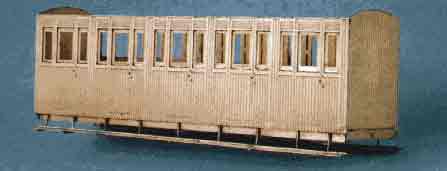



Worsley Works have become well-known in British narrow gauge modelling circles for their considerable range of 'ScratchAid' etched brass coach body kits in 4mm scale which now encompasses Irish, Welsh, and Scottish vehicles. They have recently widened their horizons with the release of their first 'foreign' stock, a number of South African bogie coaches, no doubt with a view to providing a suitable train for the Backwoods Miniatures NGGI6 Garratt.
There are initially four items in the range: a Cape Government Railways 24'7" five compartment third to drawing 456/26120 (illustrated); a CGR 24'7" four compartment first to drawing 455l16119, SAR type L-4; a CGR 24'7 brake first; SAR type N-3; and, likely to prove most useful, a South African Railways 25' type V-S guards van.
As with previous offerings, reviewed In Railway Modeller, the kits consist of sides, ends, and floor unit with fold up strengtheners and separate solebars, plus footsteps. To simplify production and keep the cost down, they do not include the roof, interior, or glazing, the wheels or any running gear, the couplings, the fixing nuts and bolts, or the brass wire for handrails or footstep brackets, and there are no 'solid' details as castings.
The components have been very nicely etched - the planking is well defined and the half-etched areas even, evidence of quality production techniques. Tabs to the fret are minimal and easily cleaned up.
Drilling out the holes for the handles, handrails, and footstep brackets is suggested but such is the standard of the etching that these are practically ready to use as they are.
The design envisages the coach body as a box with the roof fixed and a detachable floor, and accordingly stretchers are included as mounts. The solebars are separate strips, tabbed so they locate accurately in the floor. The floor has been etched to match the sides exactly, and will therefore need trimming slightly to length as the ends fit inside the sides, also adjusting the fold-up strengtheners to clear the floor mounting brackets fixed inside the ends.
The sides and ends are separate, with no form of location, but they can be accurately soldered together if care is taken, standing them on a true flat surface. It is worth reinforcing the corner with a fillet of solder.
When fitting the footsteps, the use of a template to ensure all the brackets are fixed to the same length is recommended.
These coaches are slightly unusual in that all windows had droplights. The frames are etched separately to enable them to be represented in the open position if required. Each compartment group of three is etched in the correct relationship, complete with a neat notch in one corner to clear the door handle/handrail, but it is not possible to apply the frames for the whole side in one strip. To ensure that the top edge of the frames line up perfectly, a straight-edged piece of brass - perhaps from the edge of the fret - could be soldered inside the cantrail.
The kits presume the builder will have access to drawings and photos to complete the detailing as appropriate. As well as the door handles and vertical grabs suggested, this stock had longer horizontal handrails to the right of each door.
For 4mm scale narrow gauge
Allen Doherty,
Worsley Works,
19, Douglas Road,
Worsley
M28 2SR.